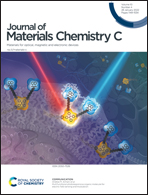Tunable magnetic order in two-dimensional layered GdGe2†
Abstract
The rise of nanoscale spintronics has aroused keen interest in intrinsic ferromagnetism in two-dimensional (2D) materials. The intensive search for 2D ferromagnets has mainly been focused on 3D/4D transition metal compounds. Here, a comprehensive theoretical investigation of the 2D ferromagnet based on the rare earth metal element, GdGe2, was performed. Our results indicate that the monolayer GdGe2 is a ferromagnetic half-semiconductor with a large magnetic moment (∼8 μB per Gd atom) and an indirect band gap of 0.55 eV. Its robust intrinsic ferromagnetism is attributed to the combined effect of the 4f–5d intra-atomic coupling and the 5d–5d inter-atomic coupling of the Gd atoms. The AB-stacking bilayer GdGe2 is a robust half-metal with a high Curie temperature (350 K), indicating promising potential as an ultrathin spin-filtering material. We found that the stacking order influences the interlayer distance and the exchange energy of the multilayer GdGe2. Significantly, the interlayer magnetic coupling can be modulated by adjusting the stacking order, and two stable stackings were identified at their interfaces, furthermore, the amount of energy required to overturn the magnetic order was quite small. Our results demonstrate the modulation of the electronic structure and the magnetic order of the 2D layered GdGe2via designing the interlayer stacking.



 Please wait while we load your content...
Please wait while we load your content...